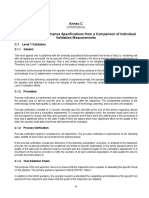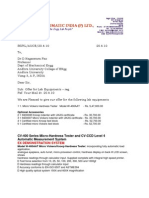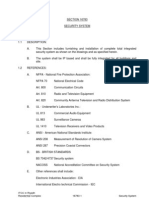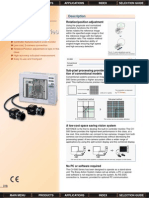Mandatory Appendix Vi - Asme V
Mandatory Appendix Vi - Asme V
Uploaded by
AngelTinocoCopyright:
Available Formats
Mandatory Appendix Vi - Asme V
Mandatory Appendix Vi - Asme V
Uploaded by
AngelTinocoOriginal Description:
Original Title
Copyright
Available Formats
Share this document
Did you find this document useful?
Is this content inappropriate?
Copyright:
Available Formats
Mandatory Appendix Vi - Asme V
Mandatory Appendix Vi - Asme V
Uploaded by
AngelTinocoCopyright:
Available Formats
2013 SECTION V
MANDATORY APPENDIX VI
DIGITAL IMAGE ACQUISITION, DISPLAY, INTERPRETATION, AND
STORAGE OF RADIOGRAPHS FOR NUCLEAR APPLICATIONS
VI-210
SCOPE
(f) spatial resolution used (see VI-241);
(g) contrast sensitivity (density range obtained) (see
VI-242);
(h) dynamic range used (see VI-243); and
(i) spatial linearity of the system (see VI-244).
Digital imaging process and technology provide the ability to digitize and store the detailed information contained
in the radiograph (analog image), thus eliminating the
need to maintain and store radiographs for permanent
record.
VI-223
VI-220
VI-221
Personnel shall be qualified as follows:
(a) Level II and Level III Personnel. Level II and Level III
personnel shall be qualified in the radiographic method as
required by Article 1. In addition, the employers written
practice shall describe the specific training and practical
experience of Level II and Level III personnel involved in
the application of the digital imaging process and the interpretation of results and acceptance of system performance. Training and experience shall be documented in
the individuals certification records.
(b) As a minimum, Level II and III individuals shall have
40 hours of training and 1 month of practical experience
in the digital imaging process technique.
(c) Other Personnel. Personnel with limited qualifications performing operations other than those required
for the Level II or Level III shall be qualified in accordance
with Article 1. Each individual shall have specified training
and practical experience in the operations to be
performed.
GENERAL REQUIREMENTS
SUPPLEMENTAL REQUIREMENTS
VI-221.1 Additional Information. Article 2, Mandatory Appendices III and IV, contain additional information
that shall be used to supplement the requirements of this
Appendix. These supplemental requirements shall be
documented in the written procedure required by this
Appendix.
VI-221.2 Reference Film. Supplement A contains requirements for the manufacture of the reference film.
VI-222
PERSONNEL REQUIREMENTS
WRITTEN PROCEDURE
A written procedure is required. The written procedure
shall be the responsibility of the owner of the radiographs
and shall be demonstrated to the satisfaction of the
Authorized Nuclear Inspector (ANI). When other enforcement or regulatory agencies are involved, the agency approval is required by formal agreement. The written
procedure shall include, as a minimum, the following essential variables:
VI-230
VI-222.1 Digitizing System Description.
(a) manufacturer and model no. of digitizing system;
(b) physical size of the usable area of the image monitor;
(c) film size capacity of the scanning device;
(d) spot size(s) of the film scanning system;
(e) image display pixel size as defined by the vertical/
horizontal resolution limits of the monitor;
(f) luminance of the video display; and
(g) data storage medium.
VI-231
EQUIPMENT AND MATERIALS
SYSTEM FEATURES
The following features shall be common to all digital image processing systems:
(a) noninterlaced image display format;
(b) WORM write-once/read-many data storage; and
(c) fully reversible (loss-less) data compression (if data
compression is used).
VI-222.2 Digitizing Technique.
(a) digitizer spot size (in microns) to be used (see
VI-232);
(b) loss-less data compression technique, if used;
(c) method of image capture verification;
(d) image processing operations;
(e) time period for system verification (see VI-264);
VI-232
SYSTEM SPOT SIZE
The spot size of the digitizing system shall be:
(a) 70 microns, or smaller for radiographs made with
energies up to 1 MeV; or
(b) 100 microns or smaller for radiographs made with
energies over 1 MeV.
26
No further reproduction or distribution is permitted.
ARTICLE 2
VI-240
SYSTEM PERFORMANCE
REQUIREMENTS
VI-252
CONTRAST SENSITIVITY EVALUATION
Using the contrast sensitivity images and the digitized
stepped density scale images to evaluate the detectability
of each density step (the observed density changes shall
be indicative of the systems capability to discern 0.02
density differences), the detectability of each density step
and the difference in density between steps shall be
evaluated.
System performance shall be determined using the digitized representation of the reference targets (images). No
adjustment shall be made to the digitizing system which
may affect system performance after recording the reference targets.
VI-241
ARTICLE 2
SPATIAL RESOLUTION
VI-253
DYNAMIC RANGE EVALUATION
Spatial resolution shall be determined as described in
VI-251. The system shall be capable of resolving a pattern
of 7 line pairs/millimeter (lp/mm) for systems digitizing
with a spot size of 70 microns or less, or 5 line pairs/millimeter for spot sizes greater than 70 microns.
The dynamic range of the digitization system shall be
determined by finding the last visible density step at both
ends of the density strip. The dynamic range shall be measured to the nearest 0.50 optical density.
VI-242
VI-254
CONTRAST SENSITIVITY
The digitization system shall be set to read the inch
scale on the reference film. The measurement tool shall
then be used to measure the scale in a vertical direction
and horizontal direction. The actual dimension is divided
by the measured dimension to find the percentage of error
in the horizontal and vertical directions.
Contrast sensitivity shall be determined as described in
VI-252. The system shall have a minimum contrast sensitivity of 0.02 optical density.
VI-243
DYNAMIC RANGE
Dynamic range shall be determined as described in
VI-253. The system shall have a minimum dynamic range
of 3.5 optical density.
VI-244
VI-260
SPATIAL LINEARITY
VI-261
Spatial linearity shall be determined as described in
VI-254. The system shall return measured dimensions
with 3% of the actual dimensions on the reference film.
VI-250
DEMONSTRATION OF SYSTEM
PERFORMANCE
PROCEDURE DEMONSTRATION
The written procedure described in VI-222 shall be demonstrated to the ANI and, if requested, the regulatory
agency, as having the ability to acquire, display, and reproduce the analog images from radiographs. Evidence of the
demonstration shall be recorded as required by VI-291.
TECHNIQUE
The reference film described in Supplement A and
Figure VI-A-1 shall be used to determine the performance
of the digitization system. The system settings shall be adjusted to optimize the display representation of the reference targets (images). The reference film and all
subsequent radiographs shall be scanned by the digitization system using these optimized settings.
VI-262
PROCESSED TARGETS
The digitizing process and equipment shall acquire and
display the targets described in Supplement A. The digitally processed targets of the reference film shall be used
to verify the system performance.
VI-263
VI-251
SPATIAL LINEARITY EVALUATION
SPATIAL RESOLUTION EVALUATION
CHANGES IN ESSENTIAL VARIABLES
Any change in the essential variables identified in
VI-222 and used to produce the results in VI-250 shall
be cause for reverification of the System Performance.
At least two of the converging line pair images (0 deg,
45 deg, and 90 deg line pairs) shall be selected near the
opposite corners of the digitizing field and one image near
the center of the digitized reference film. The spatial resolution in each position and for each orientation shall be recorded as the highest indicated spatial frequency (as
determined by the reference lines provided) where all of
the lighter lines are observed to be separated by the darker lines. The system resolution shall be reported as the
poorest spatial resolution obtained from all of the resolution images evaluated.
VI-264
FREQUENCY OF VERIFICATION
The System Performance shall be initially verified in accordance with VI-262 at the beginning of each digitizing
shift. Reverification in accordance with VI-262 shall take
place at the end of each shift or at the end of 12 continuous
hours, whichever is less, or at any time that malfunctioning is suspected.
27
No further reproduction or distribution is permitted.
2013 SECTION V
VI-265
2013 SECTION V
CHANGES IN SYSTEM PERFORMANCE
shall apply. If analog radiographs must be viewed in composite for acceptance, then both radiographs shall be digitized. The digital image of the analog radiographs shall be
interpreted singularly.
Any evidence of change in the System Performance specified in VI-240 shall invalidate the digital images processed since the last successful verification and shall be
cause for reverification.
VI-270
VI-271
VI-283
Digital images of previously accepted radiographs may
be used as a baseline for subsequent in-service
inspections.
EXAMINATION
SYSTEM PERFORMANCE REQUIREMENTS
The digitizing system shall meet the requirements specified in VI-240 before digitizing archival radiographs.
VI-272
VI-290
ARTIFACTS
VI-291
Radiographs shall be visually examined for foreign material and artifacts (e.g., scratches or water spots) in the
area of interest. Foreign material not removed and artifacts observed shall be documented.
VI-273
VI-281
CALIBRATION
EVALUATION
PROCESS EVALUATION
The Level II or Level III Examiner described in
VI-223(a) shall be responsible for determining that the digital imaging process is capable of reproducing the original analog image. This digital image shall then be
transferred to the write-once-read-many (WORM) optical
disc.
VI-282
DOCUMENTATION
REPORTING REQUIREMENTS
The following shall be documented in a final report:
(a) spatial resolution (VI-241);
(b) contrast sensitivity (VI-242);
(c) frequency for system verification;
(d) dynamic range (VI-243);
(e) Traceability technique from original component to
radiograph to displayed digital image, including original
radiographic report(s). (The original radiographic reader
sheet may be digitized to fulfill this requirement);
(f) condition of original radiographs (VI-281);
(g) procedure demonstration (VI-261);
(h) spatial linearity (VI-244);
(i) system performance parameters (VI-241); and
(j) personnel performing the digital imaging process
(VI-223).
The calibration for a specific set of parameters (i.e., film
size, density range, and spatial resolution) shall be conducted by following VI-240 and Supplement A. The results
shall be documented.
VI-280
BASELINE
VI-292
ARCHIVING
When the final report and digitized information are
used to replace the analog radiograph as the permanent
record as required by the referencing Code Section, all information pertaining to the original radiography shall be
documented in the final report and processed as part of
the digital record. A duplicate copy of the WORM storage
media is required if the radiographs are to be destroyed.
INTERPRETATION
When interpretation of the radiograph is used for
acceptance, the requirements of Article 2,
Mandatory Appendix IV and the Referencing Code Section
28
No further reproduction or distribution is permitted.
ARTICLE 2
You might also like
- Critical Crack Sizes in Ductile Piping PDFDocument23 pagesCritical Crack Sizes in Ductile Piping PDFAngelTinocoNo ratings yet
- AWS D1.1-D1.1M-2015 (WeldingWorld) 250Document1 pageAWS D1.1-D1.1M-2015 (WeldingWorld) 250Ali Clubist100% (1)
- A Proposal To Set Up A Digital Library A PDFDocument7 pagesA Proposal To Set Up A Digital Library A PDFamenu_bizunehNo ratings yet
- Passenger Information System: इरिसेट IrisetDocument124 pagesPassenger Information System: इरिसेट IrisetAbhiraj MaityNo ratings yet
- RVI Inspection ProcedureDocument3 pagesRVI Inspection ProcedureAnup NairNo ratings yet
- Hirsch Velocity Guide SpecificationsDocument27 pagesHirsch Velocity Guide Specificationsromdhan88No ratings yet
- Annex C - Api 1163Document18 pagesAnnex C - Api 1163AngelTinoco100% (1)
- Table 6.2Document1 pageTable 6.2AngelTinocoNo ratings yet
- JAH - Interchange The Promise of Digital HistoryDocument40 pagesJAH - Interchange The Promise of Digital Historyjeffbainconkin100% (1)
- Bernard Stiegler - Carnival of The New ScreenDocument10 pagesBernard Stiegler - Carnival of The New Screenfmonar01No ratings yet
- Industry 4.0 Building Your Digital Enterprise April 2016Document36 pagesIndustry 4.0 Building Your Digital Enterprise April 2016Ram KumarNo ratings yet
- Proposal of A Small Scale SK Saint Aidan Digital LibraryDocument6 pagesProposal of A Small Scale SK Saint Aidan Digital LibraryYaya BatrisyaNo ratings yet
- Mandatory Appendix Ii - Asme VDocument2 pagesMandatory Appendix Ii - Asme VAngelTinocoNo ratings yet
- Mandatory Appendix Ix - Asme VDocument3 pagesMandatory Appendix Ix - Asme VAngelTinocoNo ratings yet
- CCTV System StandardsDocument17 pagesCCTV System StandardsCyrene MamaradloNo ratings yet
- Amendment 1 - 2002Document23 pagesAmendment 1 - 2002Mamta ShindeNo ratings yet
- Ut Aws D1.1-2020Document18 pagesUt Aws D1.1-2020WilsonJavierPinedaLopezNo ratings yet
- 1 - DR MammographyDocument5 pages1 - DR MammographySwaroop PozhaylNo ratings yet
- BMS ProcedureDocument138 pagesBMS ProcedureEnar Pau100% (3)
- Software For CCTV Systems DesignDocument7 pagesSoftware For CCTV Systems DesignAPHISITH IICTNo ratings yet
- Inspection - How It WorksDocument10 pagesInspection - How It WorksSergio CruzNo ratings yet
- QRs - 3DLASERSCANNING - 01032019Document9 pagesQRs - 3DLASERSCANNING - 01032019khaireddinNo ratings yet
- WP Understanding ControlRooms 012042 LRDocument21 pagesWP Understanding ControlRooms 012042 LRrajoumn9No ratings yet
- Autonomous Hovering of A Vision/IMU Guided QuadrotorDocument6 pagesAutonomous Hovering of A Vision/IMU Guided QuadrotorKok Kai YitNo ratings yet
- Development of Automatic Welding and Inspecting System Using Machine Vision System For Nuts Welded On The Support HingeDocument7 pagesDevelopment of Automatic Welding and Inspecting System Using Machine Vision System For Nuts Welded On The Support HingetheijesNo ratings yet
- High Dynamics RadiosDocument16 pagesHigh Dynamics RadiosDaniel LimaNo ratings yet
- EPRI - Reference Film For Qualification of Radiograph Film Digitisation SystemDocument1 pageEPRI - Reference Film For Qualification of Radiograph Film Digitisation SystemSoorajNo ratings yet
- Mobile DR Mohcc - Ict - 022 - 2024 - Final-109-112Document4 pagesMobile DR Mohcc - Ict - 022 - 2024 - Final-109-112Dumisani Tawanda DubeNo ratings yet
- Andhra University 20.8.10Document6 pagesAndhra University 20.8.10Ramesh NutakkiNo ratings yet
- Jacie2012 USA Last KJDocument12 pagesJacie2012 USA Last KJChiNo ratings yet
- Presntation CcDocument27 pagesPresntation Ccrahul ponnuruNo ratings yet
- Method Statement - CCTVDocument8 pagesMethod Statement - CCTVYazan ZahalqaNo ratings yet
- CCTV Code of PracticeDocument20 pagesCCTV Code of PracticeMeijin Senjin100% (1)
- 24-CHAPTER XXIV - Digital Data ManagementDocument32 pages24-CHAPTER XXIV - Digital Data ManagementChamara PrasannaNo ratings yet
- Oe Article Machine VisionDocument4 pagesOe Article Machine Visionvikrant03No ratings yet
- Rotakin White Paper-File064826Document12 pagesRotakin White Paper-File064826karvizNo ratings yet
- AGV Controllers 2003Document10 pagesAGV Controllers 2003Nakul RNo ratings yet
- Laser Scanning TenderDocument8 pagesLaser Scanning TenderashutsNo ratings yet
- 40 78 00 - PANEL MOUNTED INSTRUMENTS - Rev01Document12 pages40 78 00 - PANEL MOUNTED INSTRUMENTS - Rev01adnanyaseenzrgrNo ratings yet
- Electrical Spec.'S CCTV System 16782-1Document12 pagesElectrical Spec.'S CCTV System 16782-1Waleed Abd El-HamiedNo ratings yet
- DD Fy09 01 042Document57 pagesDD Fy09 01 042GasTon Papi OffithielNo ratings yet
- 16783Document51 pages16783uddinnadeemNo ratings yet
- Saes T 555Document21 pagesSaes T 555Jayvee Baradas ValdezNo ratings yet
- Cvrde 3Document9 pagesCvrde 3Ansh SinghNo ratings yet
- Tata Maker ThonDocument10 pagesTata Maker ThonSujeendra RNo ratings yet
- Vision-Based Guidance and Control of A Hovering Vehicle in Unknown, GPS-denied EnvironmentsDocument6 pagesVision-Based Guidance and Control of A Hovering Vehicle in Unknown, GPS-denied Environmentsp_p9No ratings yet
- PSA 2006 - 12 - Requirements For CCTV Installation PDFDocument20 pagesPSA 2006 - 12 - Requirements For CCTV Installation PDFRaj RamachandranNo ratings yet
- Ultravim Application ManualDocument157 pagesUltravim Application ManualmhafizanNo ratings yet
- Three-Dimensional Particle Image Velocimetry: Experimental Error Analysis of A Digital Angular Stereoscopic SystemDocument11 pagesThree-Dimensional Particle Image Velocimetry: Experimental Error Analysis of A Digital Angular Stereoscopic Systemsamik4uNo ratings yet
- Net Work Survey VehicleDocument26 pagesNet Work Survey VehiclegurvinderkumarNo ratings yet
- Qcs 2010 Section 10 Part 2 Telemetry SCADADocument29 pagesQcs 2010 Section 10 Part 2 Telemetry SCADAbryanpastor106No ratings yet
- DVR 20 1Document41 pagesDVR 20 1Krisada Thongkamsai50% (2)
- Section 16781 CCTV System: King Faisal University Al-Ahsa 16781-1 CCTV System Library BuildingDocument10 pagesSection 16781 CCTV System: King Faisal University Al-Ahsa 16781-1 CCTV System Library Buildingnadeem UddinNo ratings yet
- Defect Detection and Classification On Web Textile Fabric Using Multiresolution Decomposition and Neural NetworksDocument4 pagesDefect Detection and Classification On Web Textile Fabric Using Multiresolution Decomposition and Neural Networkssatyam.pulkam7490No ratings yet
- Traffic Analysis Based On Digital Image Processing in PythonDocument7 pagesTraffic Analysis Based On Digital Image Processing in Pythonpraveena.sNo ratings yet
- Vision Measuring Machines PREDocument32 pagesVision Measuring Machines PREpuakalamNo ratings yet
- Qcs 2010 Part 10.02 Telemetry-SCADADocument29 pagesQcs 2010 Part 10.02 Telemetry-SCADARotsapNayrb100% (1)
- Marker-Based Monocular VisionDocument8 pagesMarker-Based Monocular VisionbazookavnitNo ratings yet
- Cv500 Camera, Triptico BasicoDocument7 pagesCv500 Camera, Triptico BasicoEd GarNo ratings yet
- Annexure-VI Visual Monitoring System For Watch and Ward of Substation Premises - Rev02Document8 pagesAnnexure-VI Visual Monitoring System For Watch and Ward of Substation Premises - Rev02gaurang1111No ratings yet
- QTM User Manual - 2.9Document674 pagesQTM User Manual - 2.9Andrea SpencerNo ratings yet
- An Application of NI SoftMotion RT System in A Motion Control WorkbenchDocument10 pagesAn Application of NI SoftMotion RT System in A Motion Control Workbenchggao20155No ratings yet
- Scope of Works ITC 002 2018Document18 pagesScope of Works ITC 002 2018abul abbas100% (1)
- Multisensor Instrumentation 6σ Design: Defined Accuracy Computer-Integrated Measurement SystemsFrom EverandMultisensor Instrumentation 6σ Design: Defined Accuracy Computer-Integrated Measurement SystemsNo ratings yet
- ISA Certified Automation Professional (CAP) Associate: Certification Exam Prep: 500 Practice Exam Questions and ExplanationsFrom EverandISA Certified Automation Professional (CAP) Associate: Certification Exam Prep: 500 Practice Exam Questions and ExplanationsNo ratings yet
- Advanced Techniques and Technology of Computer-Aided Feedback ControlFrom EverandAdvanced Techniques and Technology of Computer-Aided Feedback ControlNo ratings yet
- Welding Rod Cal (1) .Document7 pagesWelding Rod Cal (1) .hakr5100% (1)
- Pigging The Unpiggable PDFDocument4 pagesPigging The Unpiggable PDFAngelTinoco100% (1)
- Pof Ili 2016 VersionDocument4 pagesPof Ili 2016 VersionAngelTinocoNo ratings yet
- N Ace Direct Assessment StandardsDocument22 pagesN Ace Direct Assessment StandardsAngelTinocoNo ratings yet
- Aws It 201611Document41 pagesAws It 201611AngelTinocoNo ratings yet
- API 572 Study Guide: Practice QuestionsDocument1 pageAPI 572 Study Guide: Practice QuestionsAngelTinocoNo ratings yet
- Annex A (Normative) - AWS D1.1 - 2015Document4 pagesAnnex A (Normative) - AWS D1.1 - 2015AngelTinocoNo ratings yet
- Annex F - Api 1163Document3 pagesAnnex F - Api 1163AngelTinoco100% (1)
- Annex B (Normative) - AWS D1.1 - 2015Document2 pagesAnnex B (Normative) - AWS D1.1 - 2015AngelTinocoNo ratings yet
- Table 6.7Document2 pagesTable 6.7AngelTinocoNo ratings yet
- Table 6.3Document1 pageTable 6.3AngelTinocoNo ratings yet
- Tabla Qw-252 - Asme IxDocument1 pageTabla Qw-252 - Asme IxAngelTinocoNo ratings yet
- Annex A - Api 1163Document3 pagesAnnex A - Api 1163AngelTinocoNo ratings yet
- Mandatory Appendix III - AT - ASME VDocument2 pagesMandatory Appendix III - AT - ASME VAngelTinoco0% (1)
- Tabla Qw-252.1 - Asme IxDocument1 pageTabla Qw-252.1 - Asme IxAngelTinocoNo ratings yet
- Tamano de Catetos - Aws D1.1 PDFDocument1 pageTamano de Catetos - Aws D1.1 PDFAngelTinocoNo ratings yet
- ThefutureofgroceryretailinginSubSaharanAfrica Retailing in Sub-Saharan AfricaDocument42 pagesThefutureofgroceryretailinginSubSaharanAfrica Retailing in Sub-Saharan AfricaZhane CruzNo ratings yet
- Digitisation Big Data and The Transformation of Accounting InformationDocument23 pagesDigitisation Big Data and The Transformation of Accounting InformationKomathi Mathi100% (1)
- Byron's Last Poem - Frederick Jones (1934)Document4 pagesByron's Last Poem - Frederick Jones (1934)marceli_lNo ratings yet
- An Empirical Investigation of Pension Fund Property RightsDocument12 pagesAn Empirical Investigation of Pension Fund Property RightsMuhammad Irka Irfa DNo ratings yet
- A Voyage Around My RoomDocument81 pagesA Voyage Around My RoomLucinda Ellen BrainNo ratings yet
- Chi PDFDocument6 pagesChi PDFninazamryNo ratings yet
- Working With GeoMedia ProfessionalDocument906 pagesWorking With GeoMedia ProfessionalMiguel Alexandre100% (1)
- MII 900+ BrochureDocument2 pagesMII 900+ BrochureFábio CorreiaNo ratings yet
- IRRI AR 2012 - Supporting InformationDocument89 pagesIRRI AR 2012 - Supporting InformationIRRI_CommunicationNo ratings yet
- Writings of Samuel Adams VOL 1, 1764-1769 Ed. Harry Alonzo Cushing (1904)Document477 pagesWritings of Samuel Adams VOL 1, 1764-1769 Ed. Harry Alonzo Cushing (1904)WaterwindNo ratings yet
- Secrets of The SaharaDocument6 pagesSecrets of The Saharasahmadouk7715No ratings yet
- Introduction To GISDocument56 pagesIntroduction To GISSudharsananPRSNo ratings yet
- NLM Technical Evaluation Criteria - AV ConsultantDocument2 pagesNLM Technical Evaluation Criteria - AV ConsultantLJ's infoDOCKETNo ratings yet
- The 21st Century LibrarianDocument4 pagesThe 21st Century LibrarianArk Group100% (1)
- HYPER LITERACY IN THE EXPONENTIAL EPOCH #HypelitDocument16 pagesHYPER LITERACY IN THE EXPONENTIAL EPOCH #HypelitHenry Kannberg100% (1)
- Digitization of Cultural HeritageDocument10 pagesDigitization of Cultural HeritageNebojsa100% (1)
- 108636-11010-Types of Multimedia SystemsDocument12 pages108636-11010-Types of Multimedia SystemsRona GeorgeNo ratings yet
- Escaping The Digital Dark AgeDocument5 pagesEscaping The Digital Dark AgeKarlos lacalleNo ratings yet
- Indian Media and Entertainment Industry Report 2013Document202 pagesIndian Media and Entertainment Industry Report 2013Iyer ShankarNo ratings yet
- Copyright in Faithful Reproductions of Public Domain ArtDocument19 pagesCopyright in Faithful Reproductions of Public Domain ArtLiam WyattNo ratings yet
- Memory of The World: CII-96/WS-7Document39 pagesMemory of The World: CII-96/WS-7Talia GarzaNo ratings yet
- Local ThesisDocument12 pagesLocal ThesisMark Perfinan0% (1)
- Pollard - 1963 - Factory Discipline in The Industrial RevolutionDocument19 pagesPollard - 1963 - Factory Discipline in The Industrial RevolutionRenato Dinamarca OpazoNo ratings yet
- UDRIDocument45 pagesUDRIPooja Parekh100% (1)












































































































